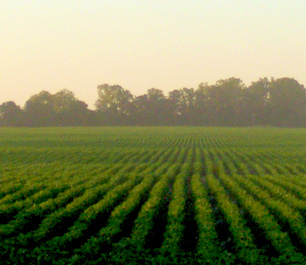DBCP (1,2-dibromo-3-chloropropane)
| EPA Maximum Contaminant Level (MCL) |
0.0002 mg/L |

DBCP can arrive in water through runoff from soybean fields.
DBCP (1,2-dibromo-3-chloropropane) is a soil fumigant used to control nematodes in a wide range of plant and vegetable crops. According to the EPA, it's used to treat soil for “cucumbers, summer squash, cabbage, cauliflower, carrots, snap beans, okra, aster, shasta daisy, lawn grasses and ornamental shrubs” and it arrives in drinking water as runoff from “soybeans, cotton, pineapples and orchards.”
Health Effects of DBCP
DBCP is a carcinogen that can lead to reproductive problems. According to the EPA:
Some people who drink water containing 1,2-dibromo-3-chloropropane in excess of the MCL over many years could experience reproductive difficulties, and may have an increased risk of getting cancer.
Water Treatment for DBCP
The EPA recommends granular activated carbon (GAC) and packed tower aeration (an air stripping method) for the treatment of DBCP. According to Lenntech, activated carbon has a “high probability” of adsorbing DBCP.
Sources: EPA, WHO, Lenntech, Photo: WikiMedia, author: Alfonso
Site Index
Filtration Systems
- Aeration for Iron & Sulfide
- Backwashing Filters
(whole house & well units)
- Chlorine & Chemical Injectors
- Countertop Water Filters
- Garden Hose Filters
- Reverse Osmosis, Residential
- Reverse Osmosis, Commercial
- Shower Filters
- Specialty Filters
- Ultraviolet Systems
- Undersink Filters
- Water Softeners
- Whole House Filters
Cartridges
Parts
- Replacement Parts
- Faucets
- Filter Media
- Fittings
- Housings
- O-rings
- Pumps
- Pura UV
- R.O. Parts
- R.O. Tanks
- R.O. Booster Pump
- VIQUA UV